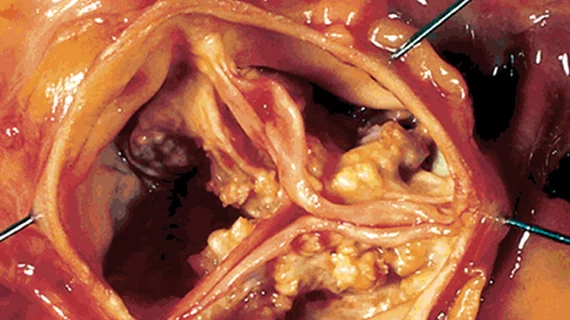Individuals who receive surgical aortic valve replacement (SAVR) within three months of an ischemic stroke are almost 15 times more likely to suffer another stroke than SAVR patients without previous strokes, according to a Danish registry study published April 25 in JAMA Cardiology.
“Recurrent stroke is associated with more severe functional disability, greater financial burden, and increased mortality compared with an incident stroke,” wrote lead author Charlotte Andreasen, MD, and colleagues. “Consequently, it is of particular relevance to investigate the association of time elapsed between previous stroke and SAVR with the risk of adverse outcomes in patients with aortic valve stenosis.”
Andreasen et al. analyzed the 30-day risks of mortality, ischemic stroke and major adverse cardiovascular events (MACE)—a composite of stroke, myocardial infarction and cardiovascular death—among 14,030 adults who underwent SAVR from 1996 through 2014.
Ischemic stroke occurred in 18.4 percent of patients who had strokes less than three months before SAVR, compared to 1.2 percent of people without previous strokes. After covariate adjustment, the odds of perioperative stroke were 14.69 times higher among those with recent strokes.
SAVRs performed three to 12 months after the incident stroke and more than a year later were associated with 4.0-fold and 2.3-fold higher risks of stroke, respectively, compared to patients without prior stroke.
“The splines of the subgroup with prior stroke supports that the risk of recurrent stroke declines with time and reaches a nadir after approximately four months,” the authors noted. “Thus, data suggest that postponement of SAVR for at least 3 to 4 months after a stroke, if possible, may reduce the risk of recurrent stroke during surgery. However, because of the observational nature of this study, the results are only hypothesis generating, and more studies are encouraged before drawing such a conclusion.”
Risks of MACE were higher in the previous stroke groups, though most of that difference could be attributed to the recurrent stroke component of MACE. All-cause mortality at 30 days wasn’t significantly different between groups after adjusting for potential confounders.
The authors acknowledged they don’t know what the 30-day stroke rate in their population would have been if surgeries hadn’t been performed, but the rates of recurrent stroke in this study were significantly higher than previous estimates from nonsurgical cohorts. This suggests the operations themselves “may heighten the risk of recurrent stroke,” they noted.
The patients who underwent SAVR within three months of a stroke may have represented a critically ill group where postponement wasn’t an option, the authors said, although they had similar comorbidities when compared to the other patients with stroke histories.
Other limitations of the study included the mostly white population, which may prevent generalizability to other races/ethnicities, and the lack of data on perioperative medications which could have influenced outcomes.
Despite these issues, the authors of an accompanying editorial agreed with Andreasen et al.’s main takeaway.
“Although this is an area that requires additional study, for now, it seems reasonable to avoid aortic valve surgery or any surgery within the first 3 months after a stroke unless the procedure is urgent or emergent and waiting would be harmful,” wrote Michael T. Mullen, MD, and Steven R. Messe, MD, both with the University of Pennsylvania. “The old saw that patience is a virtue certainly seems to hold for cardiac surgery after a stroke.”

